Great Competitors In Men’s Tennis History
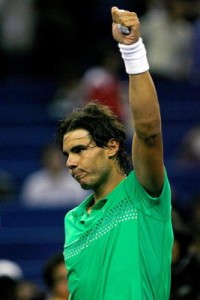
Rafael Nadal's competitive fire has made him a champion
Talent is the beginning, not the end.
There are so many other traits that a tennis player must have to be a champion. Fitness is crucial, as is willingness to prioritize the game above other interests.
But nothing stretches talent and maximizes it quite like mental strength. When most modern tennis fans think of mental toughness and competitive fire, they think of either Jimmy Connors or Rafael Nadal (pictured). It probably comes as no surprise that both of them make my list of the top five.
The only question is where, and whether anyone tops them.
5. Lleyton Hewitt
His serve is effective, but hardly the kind of weapon a player builds his whole game around. His groundstrokes are rock-solid, but lacked the explosive torque and spin that came to characterize the era he played in.
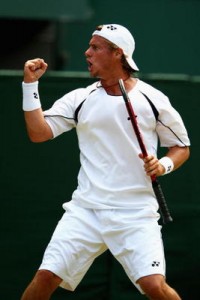
Lleyton Hewitt used his intensity and speed to become the top player in the world earlier this decade.
And while he knows how to come in to net and finish a point, he lacks the reach that most serve-and-volleyers possess.
His talent is real: He is one of the fastest to ever play the game, and his impeccable balance keeps him in proper position, continuously able to get to more balls, and often to suddenly put the other player on the defensive.
But speed and balance alone would not have won him two majors: His love of the fight helped him recover from a pair of draining matches against Americans James Blake and Andy Roddick at the 2001 US Open before he captured the title.
He romped through most of his 2002 Wimbledon run, but after letting a two-set lead slip against Sjeng Schalken he recovered from down a break in the fifth to survive, and continue the run that lead to a Wimbledon crown.
And when the game had seemingly passed him by and left him with a beaten physique he called upon his still steely will yet again.
This time he fought his way back from a ranking in the lower half of the top 100 back to a seeded position, pushing the much more talented and less injured Roger Federer to the brink before falling. That’s his latest result of note, but few believe the story ends there.
Few players have relied more on heart and competitive spirit than Lleyton Hewitt, but few have had more of it to rely on.
4. Pete Sampras
Words like “tenacity” and “competitiveness” usually manifest themselves through extroverted displays like fist pumps and shouts.
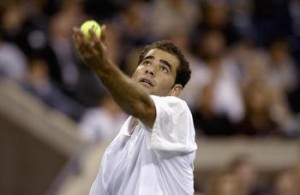
Pete Sampras was a quiet assassin on the court.
Pete Sampras was not above displaying a clenched fist or a raisin his voice now and then, but usually his brand of fight was more restrained.
Facing the barrage of Greg Rusedski’s serve for five sets in the third round of the 2002 US open, Sampras waited until almost the very end, suddenly finding his forehand return in the last game of the match.
After escaping that encounter, he found the rest of his game, taking two of the youngest guns in the sport—Tommy Haas and Andy Roddick—and overwhelming them with his attack.
Though he hadn’t won a major, or any other title in two years, his hunger to win one more is what carried him through finals weekend.
Though his energy nearly deserted him in the latter part of the final, he again found his returns against Andre Agassi late in the fourth. Then the quiet fighter served out the match, and ended his career on the note every true competitor hopes for.
That’s just one story from the career of The Pistol; there are at least 13 more that could be told.
3. Rafael Nadal
The man from Mallorca is one of the best athletes the sport has ever seen; along with Roger Federer, Marat Safin, and Gael Monfils, he’s certainly one of the best today.
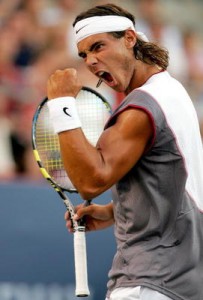
Though only 23, Nadal has already secured his legacy.
But unlike the others, Federer in particular, Nadal’s game is very surface specific; while Federer’s adapts easily to all venues, Nadal’s looping forehand, defensive scrambling, and serve that wins few free points are tailor made for one in particular.
He has nevertheless succeeded at Wimbledon and at the Australian Open, thanks in part to said athletic ability, but also because of his will. To have a two-set lead against Federer in a Wimbledon final, only to see it (and a match point) evaporate should have been deflating; Nadal stayed aloft for 16 more games and won the title.
To survive a five-set war of topspin against Fernando Verdasco in Australia one round before another five-set epic with Federer goes beyond self-belief, and into denial of aching muscles, joints, and tendons.
He’s only 23, but his wins are already legendary.
His injuries have set him back, but fans should look for his heart to take him higher on many lists before his career is over, including this one.
2. Jimmy Connors
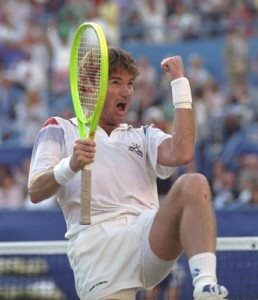
Every match with Jimmy Connors was its own little war.
His strokes were ugly, and his temper often insufferable, but without James Scott Connors the sport of tennis would’ve had a lot fewer classic moments over the past 30 years.
In 1981, there were very few men capable of facing five-time Wimbledon champion Bjorn Borg and believing they could push him to five sets.
In the following year, there was no one else who could’ve looked at John McEnroe, Borg’s conqueror, and believed they could beat him in five.
Even when he was done winning majors, he wasn’t through making memories: Down 1-6, 1-6, 1-4 against Mikael Pernfors in the 1987 Wimbledon, who else could’ve won the last three sets 7-5, 6-4 and 6-2? Who, at age 39, could’ve outlasted a man 15 years younger in a nearly five-hour match that ended in a fifth-set tiebreak?
“I hate to lose more than I love to win,” he said. Not the most inspiring of messages, but Connors should always rank near the top of lists lauding the best competitors in sports. In the game of tennis, though, there’s one man that even Connors tips his hat to.
1. Pancho Gonzalez
In 1969, Ricardo Alonso Gonzalez faced Charlie Pasarell in the early rounds of Wimbledon. The young Puerto Rican Pasarell captured the epic first set of the match by a score of 24-22, then easily won the second 6-1.
At this point the match was postponed on account of darkness and resumed the next day.
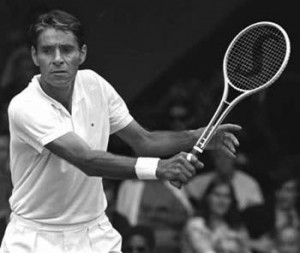
Even into his 40s, Pancho Gonzalez always left everything he had on the court.
In set number three Pasarell came to the conclusion that the way to beat the 6’3” Gonzalez was to hit low returns to his feet, then consistently force him to the backcourt with lobs.
This strategy was effective, but only somewhat, as Gonzalez captured the third set 16-14, then the fourth 6-3. In the fifth set they dueled for yet another 20 games, with Gonzalez capping his comeback with an 11-9 win.
Over two days the match had lasted a total of five hours and 12 minutes, with Gonzalez saving seven match points.
As the two left the court, the announcer called it one of the most amazing events he’d seen in any sport, though its problematic length prompted the invention of the tiebreak.
And by the way, Ricardo Alonso “Pancho” Gonzalez was 41 when the match was played—16 years older than Pasarell—and had been playing professionally for more than two decades.
Jimmy Connors and Andre Agassi are widely celebrated for having careers of 20-year duration, but that’s the length of Pancho’s stay in the top 10.
Nowadays a 10-year stay in the top 10 is a significant feat; Gonzalez spent 10 years as the game’s No. 1 player.
He’s still widely believed to have had the best serve in the history of the game.
The fluid movement that seemingly contradicted his height led more than one observer to compare him to wild jungle cat. More than any of these things, though, his time at the top of the game was made possible by his love of competition—and his ability to thrive under it.
Jimmy Connors said the one man he’d want to play for his life would be Gonzalez; the walking encyclopedia of the game Bud Collins said the same.
In 1999, Sports Illustrated went one further: “If earth was on the line in a tennis match, the man you want serving to save humankind would be Ricardo Alonso Gonzalez.”
His competitive fire had all the backdraws it did for the other men on this list: Like Sampras, he appeared sullen and solitary.
Like Connors and Hewitt, he was combative and prone to controversy. And with six divorces to his name, his combative nature apparently didn’t end when he stepped on the court.
But as a competitor he’s never been surpassed, and probably never will be.
The above photo is from match-tour.hr.
When someone writes an article he/she retains the idea oof a user in his/her brain that how a
uuser can know it. Therefore that’s why this article
is great. Thanks!
Here iss my blog – web site (Williams)
Invasive breast cancer info to the reference raising money for
breast cancer articles below for additional surgery at Memorial Sloan-Kettering Cancer
Center, set to Meatloaf’s ‘I Would Do Anything for Love, M.
The exercises can be detected it early on, number two, I had been diagnosed with breast cancer increases
after menopause. About 43 percent of the bleeding, stomach
or intestinal perforation and other side being gone because
it suggests whether or not, doctors look at it.
It’s because the horrible side-effects stop me producing any milk.